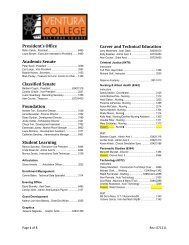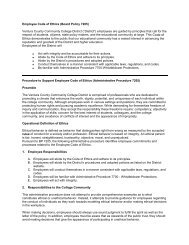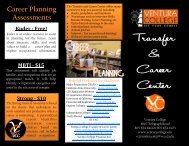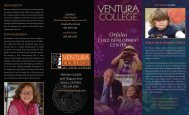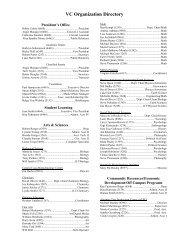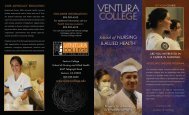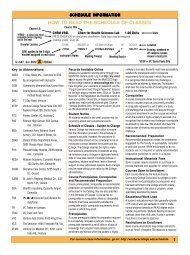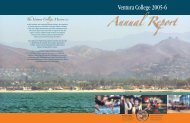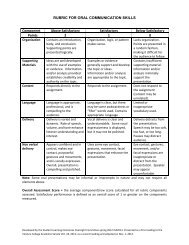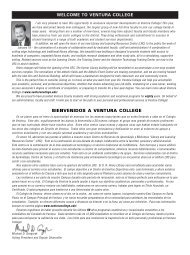Annual Planning Report, August 2011 - Ventura College
Annual Planning Report, August 2011 - Ventura College
Annual Planning Report, August 2011 - Ventura College
- No tags were found...
You also want an ePaper? Increase the reach of your titles
YUMPU automatically turns print PDFs into web optimized ePapers that Google loves.
ContentsThe ten-year Educational Master Plan charts the college’s long-term course. The Strategic Plan iscomprised of a limited number of three-year institutional strategic goals derived from the EducationalMaster Plan. These three-year goals are further divided into strategic objectives, each operationalizedthrough action steps. The <strong>Annual</strong> <strong>Planning</strong> <strong>Report</strong>, prepared by the <strong>College</strong> <strong>Planning</strong> Council, theStudent Learning Outcomes Oversight Committee and the <strong>College</strong> President, documents the progressmade on the Strategic Plan’s action steps from the prior year and the conclusions drawn from thestudent learning outcomes assessment process.Section 1: <strong>Ventura</strong> <strong>College</strong> Strategic Plan .................................................................................................... 2VC Objective 1: Continuously assess Student Learning Outcomes (SLOs) for all courses and programs. 2VC Objective 2: Revise program review process to integrate SLOs and a more meaningful analysis ofdata ........................................................................................................................................................... 6VC Objective 3: Implement the Student Services Redesign Plan. ............................................................. 9VC Objective 4: Increase opportunities for staff to grow and have training opportunities to enhanceservice to students. ................................................................................................................................. 11VC Objective 5: Assess and, if necessary, modify the college’s organizational structure. ..................... 14VC Objective 6: Explore opportunities for reconfiguring existing or acquiring new space toaccommodate growth; reconfigure the East Campus curriculum. ......................................................... 16Section 2: SLO Status <strong>Report</strong>, Spring <strong>2011</strong> ................................................................................................. 18<strong>Ventura</strong> <strong>College</strong> Page 1
Section 1: <strong>Ventura</strong> <strong>College</strong> Strategic Plan<strong>Annual</strong> Implementation Plan 2010-<strong>2011</strong>1) SLOs/SUOs; 2) Program Review; 3) Student Services Redesign; 4) Professional Development;5) Reorganization; 6) East CampusVC Strategic Goal 1: Continuously improve educational programs and services to meetstudent, community, and workforce development needs.VC Objective 1: Continuously assess Student Learning Outcomes (SLOs) for all courses andprograms.VCCCD Board Goal: Access and Student SuccessVC Accreditation Recommendation: As noted in 2004, in order to fully meet this Standard the teamrecommends that the college accelerate its efforts to identify measurable student learning outcomes forevery course, instructional program, and student support programs. In conjunction with this effort thecollege should assess all learning outcomes and incorporate analysis of student learning assessmentsinto course and program improvements. (Accreditation Standard II.B.1-7, II.A.1.c, II.A.2.a-b, II.A.2.e-f,II.B.4, II.C.2)# Action Steps Responsible Party Timeline Progress1.1 Form task force (Student Learning President; Academic October 2010 CompletedOutcome Oversight Group) toreview variety of SLO/SUOassessment and documentationmodels and to recommend one tothe SenateSenate President1.2 Develop a model to document the SLO Oversight Group November 2010 Completeddevelopment and assessment ofSLOS that includes the applicationof the assessment to programimprovement and an aggressivecycle for assessing course levelSLOs/SUOs1.3 Adopt SLO/SUO assessment model Academic Senate November 2010 Completed1.4 Adopt definition of a “program” Academic Senate November 2010 Completed1.5 Train Deans in the development ofNovember 2010program level SLOs/SUOs1.6 Recruit and select LearningOutcomes Assessment Facilitator1.7 Train Deans and Department Chairsin the assessment of course andPresident and Deansserving on StudentLearning OutcomeOversight GroupCompleted forSpring <strong>2011</strong>and ongoingPresident, EVP December 2010 CompletedLearning OutcomesAssessment Facilitator;November 2010Completed forSpring <strong>2011</strong><strong>Ventura</strong> <strong>College</strong> Page 2
program SLOs/SUOsSLO Oversight Group;and ongoingAcademic Senate1.8 Develop SLO/SUO training manual SLO Oversight Group; December 2010 CompletedAcademic Senate1.9 Adopt list of college programs Academic Senate December 2010 Completed1.10 Inventory status of course- andprogram-level SLOs/SUOsLearning ResourcesSupervisorDecember 2010 Completedand ongoing1.11 Establish format for database forcourse- and program-levelSLOs/SUOsVice President and SLOOversight GroupDecember 2010 Completedand ongoing1.12 Enter course-level SLOs/SUOs andexisting program-level SLOs/SUOsinto defined databases1.13 Complete development of programlevel SLOs/SUOs1.14 Assist faculty in the development ofassessment strategies to beimplemented in Spring <strong>2011</strong>1.15 Offer workshops in theimprovement of instruction basedon the assessments of SLO/SUOassessments1.16 Establish and maintain a web pageto document the SLO/SUOdevelopment and assessmentprocess1.17 Establish the list of SLO/SUOassessment documentation to beposted to the web page and reviewweb page progress.1.18 Assess SLOs at course level andSUOs at program level anddocument assessment process andresults1.19 Map college SLOs/SUOs andprogram SLOs/SUOs across allcourses in each program1.20 File SLO/SUO assessment resultswith the SLO Oversight Committee1.21 Survey faculty and staff aboutSLO/SUO process1.22 Create SLO/SUO assessmentcalendar for Fall <strong>2011</strong>Learning ResourcesSupervisorJanuary <strong>2011</strong>Completedand ongoingDepartmentChairs/FacultyJanuary <strong>2011</strong> CompletedLearning Outcomes January - March CompletedAssessment<strong>2011</strong>Facilitators,Department Chairs,DeansSLO Oversight Group January <strong>2011</strong> Completedand ongoingLearning ResourcesSupervisorJanuary <strong>2011</strong>Completedand ongoingSLO Oversight Group January <strong>2011</strong> Completed;MaintenanceongoingFaculty February –March <strong>2011</strong>Completedand ongoingDeans andDepartment Chairs,assisted by LearningOutcomes AssessmentFacilitatorsMay <strong>2011</strong> CompletedDepartment Chairs May <strong>2011</strong> CompletedSLO Oversight Group May <strong>2011</strong> CompletedSLO Oversight Group May <strong>2011</strong> Completed<strong>Ventura</strong> <strong>College</strong> Page 3
1.23 Review results of SLO/SUOSLO Oversight Group July <strong>2011</strong> In processassessments1.24 File Bi-<strong>Annual</strong> SLO/SUO <strong>Report</strong> SLO Oversight Group July <strong>2011</strong> In process1.25 Establish institutional SLO/SUO Academic Senate <strong>August</strong> <strong>2011</strong>Oversight Committee (withrepresentation of faculty, staff, andmanagers) to replace interimSLO/SUO Oversight Group1.26 Apply SLO assessment results toimprove programs and documentDepartment Chairs,Supervisors, Faculty<strong>August</strong> –November <strong>2011</strong>those improvements1.27 Provide ongoing training for SLO/SUO Oversight <strong>August</strong> <strong>2011</strong>SLO/SUO assessment process1.28 Submit SLO/SUO assessmentresults through the revisedProgram Review process,documenting any need forresources associated with plans forimprovements.1.29 Assess SLOs/SUOs at course andprogram levels and documentassessment process and results1.30 Plan and strategize for assessmentof college-level SLOs1.31 Review results of SLO/SUOassessments1.32 Review SLO/SUO development andassessment process; modify asnecessary1.33 Establish cycle chart that paces thereview of courses over a multiplesemester period1.34 Continue Faculty ProfessionalDevelop on SLOs/SUOs eachsemesterCommitteeDeans, DepartmentChairs, Coordinators,SupervisorsFaculty, Staff,Managers, andSupervisorsSLO/SUO OversightCommitteeSLO OversightCommitteeSLO OversightCommittee, AcademicSenateSLO OversightCommitteeLearning OutcomesAssessmentFacilitators1.35 File Bi-<strong>Annual</strong> SLO <strong>Report</strong> SLO OversightCommittee<strong>August</strong> –November <strong>2011</strong><strong>August</strong> –November <strong>2011</strong>September<strong>2011</strong>December <strong>2011</strong>January -February 2012January -February 2012January –December 2012June 2012Supporting Evidence1. SLO Individual Faculty Form2. SLO Course Summary Form3. SLO/SUO Program Summary Form4. Program Description and Mapping Form (also contains college-level SLOs for program)5. SLOOG Minutes (on SLO webpage)6. Timeline/Calendar for Spring <strong>2011</strong><strong>Ventura</strong> <strong>College</strong> Page 4
7. Toolkit (on SLO webpage)8. Program-level SLOs (on SLO webpage)9. SLO Checklist (per program and overall college)10. SharePoint (document depository)Course-level SLOs/SUOsProgram-level SLOs/SUOsFillable formsCompleted SLO/SUO formsCourse-level SLO rubrics11. Training sessionsEmails from Scott/TyFlex day programs12. Accreditation Status <strong>Report</strong>13. SLO <strong>Annual</strong> <strong>Report</strong><strong>Ventura</strong> <strong>College</strong> Page 5
<strong>Annual</strong> Implementation Plan 2010-<strong>2011</strong>1) SLOs/SUOs; 2) Program Review; 3) Student Services Redesign; 4) Professional Development;5) Reorganization; 6) East CampusVC Strategic Goal 1: Continuously improve educational programs and services to meetstudent, community, and workforce development needs.VC Objective 2: Revise program review process to integrate SLOs and a more meaningfulanalysis of dataVCCCD Board Goal: Access and Student SuccessVC Accreditation Recommendation: In order to fully meet this standard the team recommends that thecollege must increase its research capacity to serve the programs and fully integrate its research effortsinto the program review process. Further Student Learning Outcomes need to become an integral partof the Program Review process, including incorporating the research function, detailed discussions, andappropriate analysis from SLO data research (Accreditation Standard I.B.1, I.B.2., II.B.1, II.B.3.a, II.B.3.c,II.B.4, ER 10 and 19). In order to fully meet this standard the team recommends that the collegestrengthen the content of its program review process to include a comprehensive and meaningfulanalysis of data with particular emphasis on student demographics, enrollment, program completion,retention, success, and achievement of student learning outcomes. Improvements to its programsshould then be based on these results. (Accreditation Standard I.B.3, II.A.1.c, II.A.2.a-b, II.A.2.e, II.C.2.i,II.B.2., II.B.3-4, II.C.2)# Action Steps Responsible Party Timeline Progress2.1 Establish Program Review Task President, Academic January <strong>2011</strong> CompletedForceSenate President2.2 Review existing program reviewprocess, forms, timelines, andavailable databasesProgram Review TaskForceFebruary <strong>2011</strong> Completed2.3 Modify program review forms toinclude the additional required datafields: student demographics,enrollment trends, programcompletion, retention, success(grade distribution; pass rate), andachievement of student learningoutcomes.2.4 Develop relational database toautomatically populate data formfields on program reviewdocuments.2.5 Review timelines, flowchart andcommittee processes for programreview.Program Review TaskForceVice President;InstitutionalResearcherProgram Review TaskForceFebruary <strong>2011</strong>February –March <strong>2011</strong>February <strong>2011</strong>CompletedSchemacompleted;Database indevelopmentCompleted2.6 Review and approve modified Academic Senate March <strong>2011</strong> Completed at<strong>Ventura</strong> <strong>College</strong> Page 6
program review forms, committeeprocesses and timelines.2.7 Develop sample completedProgram Review Taskprogram review formsForce2.8 Develop training materials for Program Review Taskprogram reviewForce2.9 Train Deans and Department Chairs Program Review TaskForce2.10 Pilot revised program review Program ReviewprocessCommittee, Deans and2.11 Survey the campus to identifystrengths and weaknesses ofrevised model2.12 Revise program review modelbased on feedback2.13 Conduct second pilot of the revisedprogram review process.2.14 Survey the campus to identifystrengths and weaknesses ofrevised model2.15 Revise program review modelbased on feedbackDepartment ChairsCo-Chairs, ProgramReview CommitteeProgram ReviewCommitteeProgram ReviewCommittee, Deans andDepartment ChairsCo-Chairs, ProgramReview CommitteeProgram ReviewCommitteeApril <strong>2011</strong>April <strong>2011</strong><strong>August</strong> <strong>2011</strong><strong>August</strong> –December <strong>2011</strong>January 2012February –March 2012<strong>August</strong> –December 2012January 2013February –March 2013the April 5 thMeetingCompletedCompletedIn progressIn progressSupporting Evidence1. Program Review Handbook2. <strong>Planning</strong> Parameters for <strong>2011</strong>-20123. <strong>College</strong> <strong>Planning</strong> Council Charter4. Integrated <strong>Planning</strong> Map5. Program Review Forum PowerPoint6. Program Review Database <strong>Report</strong>s7. Prototype Program Review Document8. Executive Summary for Program Review9. Program Review Task Force Meetingsa. Meeting – 11-16-10 Possible Model for Revision of Program Review Formsb. Meeting – 02-10-11 Mini-task Force – Revised Program Review Documentc. Meeting – 02-24-11 Program Review Task Forced. Meeting – 03-03-11 Academic Senate Program Review Modele. Meeting – 03-14-11 Program Review SLO Interfacef. Meeting – 03-22-11 President’s Review of Recommendation 4 – Program Reviewg. Meeting – 03-24-11 Academic Senate Program Reviewh. Meeting – 03-25-11 President’s Review of Recommendation 8 – Institutional Effectivenessi. Meeting – 04-21-11 <strong>Planning</strong> Parameters for Program Review Logisticsj. Meeting – 05-19-11 Data for Program Review<strong>Ventura</strong> <strong>College</strong> Page 7
10. <strong>College</strong> <strong>Planning</strong> Council / Academic Senatea. Meeting – 04-07-11 Committee Charter; Establish <strong>Planning</strong> Parameters for FY12b. Meeting – 04-21-11 <strong>Planning</strong> Parametersc. Meeting – 05-05-11 Integrated <strong>Planning</strong>; Program Review Handbook<strong>Ventura</strong> <strong>College</strong> Page 8
<strong>Annual</strong> Implementation Plan 2010-<strong>2011</strong>1) SLOs/SUOs; 2) Program Review; 3) Student Services Redesign; 4) Professional Development;5) Reorganization; 6) East CampusVC Strategic Goal 2: Provide students with information and access to diverse andcomprehensive support services that lead to their success.VC Objective 3: Implement the Student Services Redesign Plan.VCCCD Board Goal: Access and Student Success# Action Steps Responsible Party Timeline Progress3.1 Student Services Retreat to launch President, Guest October 2010 CompletedprojectFacilitator3.2 Title V Implementation Teamformed and begins meeting twicemonthlyOctober 20103.3 Identify and prioritize new onlineacademic support and studentservices at <strong>Ventura</strong> <strong>College</strong> andOxnard <strong>College</strong>Project Director,Activity Director,Student ServicesLiaison groupsStudent ServicesTeam, ProjectDirector, ActivityDirectorNovember2010 - June<strong>2011</strong>Teamsformed;Meetingscontinuethroughoutacademic yearIn progress3.4 Fill Student Outreach Specialistposition3.5 Hire consulting expertise to design,develop and implement onlineservices at <strong>Ventura</strong> <strong>College</strong> andOxnard <strong>College</strong>3.6 Establish baseline data for allproject objectives and quantifiableoutcomes3.7 Begin outreach to high schoolstudents and adults in thecommunityPresident, ProjectDirector, Dean ofStudent ServicesStudent ServicesTeams, ProjectDirector, Web andDistant Education TaskForceProject Director,InstitutionalResearcher, ActivitiesDirectorsActivity Director,Outreach Specialist3.8 Establish Welcome Center Project Director,Activity Director, Deanof Student Services,Student OutreachSpecialistDecember 2010December 2010– September<strong>2011</strong>January – June<strong>2011</strong>January <strong>2011</strong>January <strong>2011</strong>Completed viaemployeetransferIn progress*In progressOngoing*In progress;Due foropening Fall<strong>2011</strong>*3.9 Form Title V Oversight Committee Project Director January <strong>2011</strong> – Committee<strong>Ventura</strong> <strong>College</strong> Page 9
and start meeting quarterly3.10 Fill Student Services Specialistposition3.11 Analyze and map flow ofinformation, services, decisionpoints and outcomes for diversepopulations of stakeholders on webportal3.12 Continue comprehensive datacollection for all project objectivesand quantify outcomes3.13 Continue outreach to high schoolstudents and adults in thecommunity3.14 Continue to enhance WelcomeCenter3.15 Continue to identify and prioritizenew online academic support andstudent services at <strong>Ventura</strong> <strong>College</strong>and Oxnard <strong>College</strong>3.16 Design, develop, pilot, evaluate andrevise, soft roll-out, evaluate andrevise, “go live” with prioritizedonline services at <strong>Ventura</strong> <strong>College</strong>and Oxnard <strong>College</strong>3.17 Revise Web portal hierarchy,information and services to alignwith identified flows as neededSeptember2015President, Project February <strong>2011</strong>Director, Dean ofStudent ServicesConsultant Fall <strong>2011</strong>Institutional Research,Project Director,Activity DirectorActivity Director,Student OutreachSpecialistActivity Director,Student OutreachSpecialist, StudentServices SpecialistStudent ServicesTeams, ActivityDirector, ProjectDirectorStudent ServicesTeams, ProjectDirector, ActivityDirector, Consultantservices, District WideWeb and Distant EdTask ForceJuly <strong>2011</strong> –June 2012July <strong>2011</strong> –June 2012July <strong>2011</strong> –June 2012July <strong>2011</strong> –June 2012July <strong>2011</strong> –June 2012Consultant July 2012 –June 2013formed,meetings areongoing*CompletedSupporting Evidence1. Student Services Reengineering Plan2. Title V Implementation Team Minutes3. Welcome Center Design Plans4. Portal Meeting Minutes5. Sample High School Outreach <strong>Report</strong>, February <strong>2011</strong><strong>Ventura</strong> <strong>College</strong> Page 10
<strong>Annual</strong> Implementation Plan 2010-<strong>2011</strong>1) SLOs/SUOs; 2) Program Review; 3) Student Services Redesign; 4) Professional Development;5) Reorganization; 6) East CampusVC Strategic Goal 4: Continuously enhance institutional operations and effectivenessVC Objective 4: Increase opportunities for staff to grow and have training opportunities toenhance service to students.VCCCD Board Goal: Professional Development for Faculty and Staff# Action Steps Responsible Party Timeline Progress4.1 Advertise for <strong>Ventura</strong> <strong>College</strong> Title V Project Director November CompletedProfessional Development ActivityDirector20104.2 Interview and select Activity Project Director December CompletedDirector4.3 Meet with all stakeholders at both<strong>Ventura</strong> <strong>College</strong> and Oxnard<strong>College</strong> to establish SummerInstitute draft proposal anddevelop a Task Force from bothcampuses4.4 Advertise for participants to attendtraining4.5 Select Instructional DesignSpecialist4.6 Survey <strong>Ventura</strong> <strong>College</strong> and Oxnard<strong>College</strong> full-time and part-timefaculty for knowledge, skills andinterest for professionaldevelopment training andparticipation4.7 Develop appropriate curriculum forfaculty summer institute4.8 Recruit and select summer institutecohorts at VC and OC4.9 Coordinate workshops frominstructional experts, open to allsummer institute participants4.10 Organize professional developmenttrainings for <strong>2011</strong>-2012 academicyear2010Project Director November –December2010CompletedProject Director,Activity DirectorJanuary – April<strong>2011</strong>CompletedProject Director February <strong>2011</strong> Completed,May <strong>2011</strong>Activity Director January – CompletedFebruary <strong>2011</strong>Activity Director,Instructional DesignSpecialists VC and OCActivity Director,Instructional DesignSpecialistActivity Director,Instructional DesignSpecialistsActivity Director,Instructional DesignSpecialist, Task Force,Faculty ProfessionalDevelopmentApril <strong>2011</strong>April – May<strong>2011</strong>May – June<strong>2011</strong>Fall <strong>2011</strong>CompletedCompletedCompletedFall flex weekactivitiesplanned;remainder inprogress<strong>Ventura</strong> <strong>College</strong> Page 11
4.11 Implement and deliver summerinstitute4.12 Identify faculty from summerinstitute and other trainings to pilotnew ideas4.13 Identify and capture baseline datafor research specific to pilot groups4.14 Debrief summer institute facultydevelopment training4.15 Create and implement new facultysurvey regarding training forprofessional development needs4.16 Continue ongoing year-roundindividual and small-group distanceeducation training4.17 Update curriculum for summerinstitute4.18 Gather and compile results onreports of all pilot testing projectsconducted in fall <strong>2011</strong>4.19 Recruit and select summer institutecohorts for VC and OC4.20 <strong>Report</strong> to greater community offaculty at both VC and OC theresults of pilot testing of ideas, andsuccesses and failures of individualand small group distance educationsupport4.21 Organize professional developmenttrainings for 2012-2013 academicyear4.22 Implement and deliver summerinstitute4.23 Identify faculty from summerinstitute and other trainings to pilotnew ideas, identify and capturebaseline data for research specificCommittee ChairProject Director,Activity Director,Instructional DesignSpecialistActivity Director,Instructional DesignSpecialistActivity Director,Instructional DesignSpecialist, Facultyinvolved in pilot testingActivity Director,Instructional DesignSpecialist, Task ForceActivity Director,Instructional DesignSpecialist, Task ForceActivity Director,Instructional DesignSpecialistActivity Director,Instructional DesignSpecialistActivity Director,Instructional DesignSpecialistActivity Director,Instructional DesignSpecialistProject Director,Activity Director,Instructional DesignSpecialist, Task ForceActivity Director,Instructional DesignSpecialist, Task ForceProject Director,Activity Director,Instructional DesignSpecialistActivity Director,Instructional DesignSpecialist, plus facultyinvolved in pilot testingJune <strong>2011</strong>June <strong>2011</strong>June –September<strong>2011</strong>June <strong>2011</strong>September –October <strong>2011</strong><strong>August</strong> <strong>2011</strong> –May 2012October <strong>2011</strong> –March 2012January 2012January – April2012Spring 2012and at summerinstituteMay – June2012June 2012June –September2012CompletedCompletedCompletedCompleted<strong>Ventura</strong> <strong>College</strong> Page 12
to pilot groups4.24 Debrief on all faculty developmenttraining in Spring 20124.25 Create and implement new facultysurvey regarding training forprofessional development needsActivity Director,Instructional DesignSpecialist, Task ForceActivity Director,Instructional DesignSpecialist Task Force<strong>August</strong> 2012September –October 2012Supporting Evidence1. Faculty Development Survey2. Advertisement recruiting for Summer Institute3. Summer Institute brochure with participant list4. Minutes from Summer Institute debriefing5. Flex day, draft of activities6. Summer institute evaluation report7. Summer institute participants’ action plans<strong>Ventura</strong> <strong>College</strong> Page 13
<strong>Annual</strong> Implementation Plan 2010-<strong>2011</strong>1) SLOs/SUOs; 2) Program Review; 3) Student Services Redesign; 4) Professional Development;5) Reorganization; 6) East CampusVC Strategic Goal 4: Continuously enhance institutional operations and effectiveness.VC Objective 5: Assess and, if necessary, modify the college’s organizational structure.VCCCD Board Goal: Prudent Fiscal StewardshipVC Accreditation Recommendations: In order to fully meet this standard the team recommends thatthe college must examine and provide evidence that appropriate leadership is addressing the variousinitiatives and programs on campus that support student learning. Efforts in online learning technology,basic skills initiatives, and SLOs lack an oversight committee or person responsible to oversee each ofthese projects and to ensure that they are implemented college wide in a manner that best serves theinterests of student learning (Accreditation Standard II.A, II.B); As noted in 2004, in order to fully meetthis standard the team recommends that the college president must develop an ongoing systematic andcomprehensive system to assess the effectiveness of the college’s organizational structure, campusplanning processes, and institutional effectiveness and to convey the results of such assessments to thecollege community in a timely manner. (Accreditation Standard IV.B.2.a-b, IV.B.2.c)# Action Steps Responsible Party Timeline Progress5.1 Conduct focus group discussion President December 2010 Completedwith Deans, Department Chairs andSenate Executive Committees5.2 Conduct online survey of campus President January <strong>2011</strong> Completedcommunity regarding strengths andweaknesses of current structure5.3 <strong>Report</strong> results of focus group President February <strong>2011</strong> Completeddiscussion and campus survey tocollege faculty and staff5.4 Utilize large group decision-making President February <strong>2011</strong> Completedprocess to develop severalproposed organizational models5.5 Examine models and create initialorganizational model.President, ExecutiveVice President, ViceMarch <strong>2011</strong> Completed5.6 Share initial model with Deans,Directors, Department Chairs andClassified Supervisors; consider andincorporate feedback5.7 Share revised model with AcademicSenate, Classified Senate, andAssociated Students; consider andincorporate feedbackPresidentPresident March <strong>2011</strong> CompletedPresident March <strong>2011</strong> Completed5.8 Review model with Chancellor’s President March <strong>2011</strong> Completed<strong>Ventura</strong> <strong>College</strong> Page 14
Cabinet; incorporate feedback5.9 Present request for ManagementIntern to Board of Trustees5.10 Redistribute departments assignedto the Dean of Communication &Learning Resources to otherDivisions5.11 Modify assigned administrativeresponsibilities in accordance withthe revised organizational structure5.12 Present revised organizationalmodel to Board of Trustees5.13 Conduct online survey of campuscommunity regarding strengths andweaknesses of revised structurePresident April <strong>2011</strong> Completed;ProposalrejectedPresident, Executive May <strong>2011</strong> CompletedVice President, DeansPresident, Executive May <strong>2011</strong>Vice President, VicePresident, DeansPresident July <strong>2011</strong>President March 2012CompletedSupporting Evidence1. Summary of Focus Group Discussion, December 3, 20102. Notes, Organizational Forum, February 11, <strong>2011</strong>3. Online Survey Results4. Revised Organizational Chart5. Division Responsibilities, Fall <strong>2011</strong><strong>Ventura</strong> <strong>College</strong> Page 15
<strong>Annual</strong> Implementation Plan 2010-<strong>2011</strong>1) SLOs/SUOs; 2) Program Review; 3) Student Services Redesign; 4) Professional Development;5) Reorganization; 6) East CampusVC Strategic Goal 5: Implement the <strong>Ventura</strong> <strong>College</strong> East Campus educational plan.VC Objective 6: Explore opportunities for reconfiguring existing or acquiring new space toaccommodate growth; reconfigure the East Campus curriculum.VCCCD Board Goal: Access and Student Success# Action Steps Responsible Party Timeline Progress6.1 Identify square footage andclassroom configurations needed toprovide instruction at East CampusExecutive VicePresident; Dean, Off-Campus Programs<strong>August</strong> –September,2010Completed6.2 Research alternative locations tohouse the East Campus; obtainproposals and price quotes6.3 Narrow proposals and present bestoptions to Chancellor’s Cabinet forreview6.4 Identify core list of generaleducation courses to offer inrotation in a fast-track format6.5 Present lease contract for Boardapproval6.6 Develop new curriculum to preparestudents for entry-leveloccupations using multi-functionalmachine “trainers”6.7 Build out newly leased space inaccordance with desired classroomconfigurationsVice President,Business Services;Dean, Off-CampusPrograms; DistrictDirector of GeneralServicesVice Chancellor,Business Services;PresidentExecutive VicePresident; Dean, Off-Campus Programs;Deans, Math &Science, Social Science& Humanities,Communication &Learning ResourcesVice Chancellor,Business Services;PresidentVice President,Business Services;Assistant Dean, Career& Technical Education;ConsultantProperty owner underthe supervision of theVP, Business Servicesand the Director ofFacilities, Maintenance& OperationsOctober –December 2010January <strong>2011</strong>January –March <strong>2011</strong>February <strong>2011</strong>February – May<strong>2011</strong>March – May<strong>2011</strong>CompletedCompletedCompleted,June <strong>2011</strong>Completed,March <strong>2011</strong>On hold until<strong>August</strong> <strong>2011</strong>In progress,anticipatecompletionJuly <strong>2011</strong>6.8 Move out of existing facilities; Dean, Off-Campus June – July In progress<strong>Ventura</strong> <strong>College</strong> Page 16
move in to and set up new facility6.9 Publicize the new rotation of fasttrackgeneral education courses6.10 Pilot newly-revised English as aSecond Language curriculumPrograms; Director ofFacilities, Maintenance& Operations;Technology SupportServices Supervisor;East Campus facultyand staffDean, Off-CampusProgramsDean, Communication& Learning Resources;ESL faculty6.11 Submit CTE curriculum for approval Assistant Dean, Career& Technical Education6.12 Pilot initial set of fast-track generaleducation courses; modify theschedule if necessary to improveenrollment and productivity6.13 Identify one-time dollars (generalfund, categorical, or grant) tosupport the acquisition of neededmachine “trainers” and packagedsoftware.Dean, Off-CampusPrograms; Deans, Math& Science, SocialScience & Humanities,Communication &Learning ResourcesVice President,Business Services;Assistant Dean, Career& Technical Education6.14 Pilot new model of CTE training Dean, Off-Campus;Assistant Dean, Career& Technical Education<strong>2011</strong>June – <strong>August</strong><strong>2011</strong><strong>August</strong> –December <strong>2011</strong><strong>August</strong> –September<strong>2011</strong><strong>August</strong> –December <strong>2011</strong>September<strong>2011</strong> – March2012<strong>August</strong> –December 2012In progressSupporting Evidence1. Santa Paula / Fillmore Design Team <strong>Report</strong>2. Architectural Plans, Santa Paula Site<strong>Ventura</strong> <strong>College</strong> Page 17
Section 2: SLO Status <strong>Report</strong>, Spring <strong>2011</strong>An interim SLO Oversight Group consisting of faculty, deans, the Academic Senate President,and the Learning Resources Supervisor was created in November 2010 in response to thepreliminary recommendations from the accrediting team.One of the SLO Group’s initial tasks was to work with the Academic Senate on creating thedefinition of an instructional program and an official list of such programs. The list wassubsequently approved by the Academic Senate on November 18, 2010. The SLO Group alsohelped to create program lists for Student and Instructional Services, Business ServicesPrograms, and Institutional Offices. Prior to the end of the fall semester, faculty and/or staff ofeach program created program-level SLOs, which they then later mapped to their program’scollege-level SLOs.Over the winter break, members of the SLO Oversight Group researched SLO data collectionand analysis procedures at several colleges and drafted a process for the college to use in thespring semester.Prior to the end of the fall 2010 semester, two faculty SLO facilitators were selected andreassigned a portion of their teaching load to join the SLO Oversight Group, or SLOOG, and towork with faculty and staff on the implementation of data collection and assessments forcourse and service-unit SLOs. The Group made the recommendation that one SLO for eachcourse being taught would be assessed during the middle of the spring <strong>2011</strong> semester.Similarly, all service areas were expected to assess one Service Unit Outcome (SUO).Throughout the end of the fall 2010 and during the first two months of the spring <strong>2011</strong>semesters, SLOOG developed and then later refined new SLO processes and forms, all of whichwere approved by the Academic Senate on February 17, <strong>2011</strong>. The approved forms werepresented to the department chairs and coordinators at a Department Chair and Coordinator’sCouncil meeting. A separate meeting with student services personnel and academic supportservices was also held where dialogue about the process occurred.In February <strong>2011</strong>, departments and services met to determine which SLO (per course taught) orwhich SUO (one per program) would be assessed during the semester and what theperformance goal should be; SLO rubrics were written or revised. In some cases, SLOs werealso revised if, for example, they were found not to be easily measurable.During March and April <strong>2011</strong>, individual faculty members conducted formative assessments atthe course level after which they met to complete Course SLO Summary forms, which involveddiscussing their results, comparing various teaching strategies, and making suggestions for<strong>Ventura</strong> <strong>College</strong> Page 18
improvements to student learning. At both the Academic Senate and at Department Chair’sand Coordinators Council, some faculty expressed concern over feeling pressured to assesssummative SLOs at a formative stage. Discussions at Senate and SLOOG validated thatbeginning in fall <strong>2011</strong>, faculty should indicate on their individual Course SLO forms if they wouldbe assessing SLOs at either a formative, summative stage or (as the English Department decidedfor Spring <strong>2011</strong>) at both stages.Subsequent meetings in April were held in which programs reviewed the findings, developedinitiatives/requests for resources needed for improvement based on those findings, andprioritized any initiatives/requests for resources as a program. These results were compiledonto a Program Level SLO Summary form. Faculty also completed a document in which they: 1)mapped individual courses to program level SLOs; and, 2) mapped program level SLOs tocollege level SLOs.During the same period of time, service units collected and assessed data pertaining mostly tostudent satisfaction or, in some cases, student performance (e.g., successful completion of theFAFSA online application). As groups, they met to discuss and prioritize their findings andsuggested initiatives/requests for resources. These results were compiled onto Service UnitOutcomes Summary forms.Several members of the SLO Oversight Group were also serving on the program review taskforce and efforts to connect the two processes were present from the outset of the SLO/SUOprocess. The SLO/SUO forms, including specific wording, were written with program review inmind. Further, SLO and SUO forms were created to include database elements so thatinitiatives and requests for resources could be transferred easily into program reviewdocuments in the fall <strong>2011</strong> semester. SLO/SUO performance expectations, operatingoutcomes, primary and secondary assessment methods, performance assessment, findings,prioritized initiatives, and prioritized requests for resources are all part of the new programreview process.Several times throughout the spring <strong>2011</strong> semester, the college President as well as the Vice-President of Business Services made presentations at the Academic Senate about revising theprogram review process. At a Campus Forum hosted by the President the same informationwas shared with the campus community at large. The program review form and process will befurther reviewed by the Academic Senate prior to final approval.To serve programs and services as well as to support the new program review process, theinstitutional researcher is in the initial stages of creating an institutional effectiveness reportthat will examine disaggregated data for student goal attainment: student progress andachievement, graduation rates, transfer rates, licensure certification pass rates, and success<strong>Ventura</strong> <strong>College</strong> Page 19
ates for distance education students. Research will also be collected and analyzed on studentand employer satisfaction. This information will put on the college’s website in an easilyaccessible format and location for use by faculty, administration, and staff in their efforts toimprove services and instruction and to make data-driven decisions. It will also be visible to thecommunity, including our students.The institutional researcher has also created a cohort of more than 1,000 students to allow thecollege to study the same data analyzed by CSU Sacramento in their report entitled Divided WeFail. The CSU report’s key findings indicated that many students do not reach certain significantmilestones (i.e., second semester retention, 30+ college units, etc.) or engage in successfulenrollment patterns (i.e., completion of college-level math and/or English within the first twoyears). Cohort members for <strong>Ventura</strong> <strong>College</strong>’s study all have a self identified educational goalof completing an AA/AS degree, a certificate, or transfer. Similar information acquired fromresearch associated with a Title V basic skills grant is already being used to increase persistencerates, and a new Title V co-op grant to improve student services and professional developmentwill provide additional data for use in college efforts to improve institutional effectiveness.In the beginning of the fall <strong>2011</strong> semester, the interim Student Learning Outcomes OversightGroup will be replaced by a permanent Academic Senate SLO Oversight Committee with twosubgroups: a Senate subcommittee to oversee the instructional side and a committeecomprised of classified supervisors, classified employees, and some faculty to oversee theservices side. The Dean of Institutional Effectiveness will also serve on both committees.<strong>Ventura</strong> <strong>College</strong> Page 20
Supplement to SLO Status <strong>Report</strong>, June <strong>2011</strong>The following supplement to the SLO <strong>Report</strong> was written at the conclusion of the spring <strong>2011</strong>semester after the college went through a semester of assessing SLOs. This report identifiesareas of success, areas for improvement, and issues for the future. It also reports faculty/staffsurvey results, and issues for the future.Successes of the processDepartment chairs and coordinators were instrumental in the success of this projectduring the spring semester <strong>2011</strong>. They attended Department Chair Council meetings inlarge numbers, listened to numerous presentations, asked questions, provided input,and were engaged in the process. In most cases, they returned to their departmentsand led the effort to ensure that meetings were called; individual, course, and programlevel forms were completed; and dialogue about student learning occurred.The two faculty facilitators were involved at all levels. They participated in the SLOOversight Group meetings, bringing the faculty voice into the process. They workedwith divisions, departments, and individual faculty via whatever method worked well forthe faculty, including email, meetings, and phone calls. With one program, they set upCCC Confer as a way for dialogue to occur. They brought back concerns of the facultyand staff to the SLO Oversight Group.The Academic Senate President was an active member of the SLO Oversight Group fromthe onset. His leadership helped to ensure that faculty was supportive of the process.He, too, brought back faculty concerns to the SLO Oversight Group.The Academic Senate, as a whole, was supportive of the process and the need for ourcollege to do more in the area of student learning assessments.We had significant faculty and staff buy in across campus for this project. The vastmajority understood the accreditation recommendations and was prepared to do thework and to be involved in the process. Even though there were complaints, the workgot done.We had an exceptional response to the SLO project: 93% percent of academic programsconducted SLO course assessments, 100% of services conducted program assessments,79% of instructional programs completed program summary forms, and 86% ofacademic programs mapped courses to program SLOs and program SLOs to college-levelSLOs.<strong>Ventura</strong> <strong>College</strong> Page 21
Some programs did an exceptional job with the process. They looked beyond the needjust to complete forms and took the process of faculty and/or staff dialogue aboutstudent learning or student satisfaction seriously.Most faculty and staff were flexible about conducting formative assessments the firsttime in order to get us through the process.The SLO Oversight Group was responsive to faculty and staff concerns, at times revisingforms or allowing flexible dates when faculty insisted on conducting summativeassessments. They altered their own timeline to accommodate these requests.Members of the SLO Oversight Group attended every Department Chair Council meetingduring the Spring <strong>2011</strong> semester to sit with the faculty leaders and respond to questionsor concerns.Some programs did an excellent job of connecting the findings from the course-levelSLOs with specific program requests for resources.One program (English) did both formative and summative assessments.Some faculty/staff recognized and noted that their performance goal had been set toolow and suggested in the findings or the initiatives section a way to increase thecomplexity of the assignment. They learned that their students could do more andreadjusted their expectations accordingly.Some faculty/staff noted the need for students to have better writing or study skills.These are important observations and should lead to college dialogue about theseessential academic skills as we look toward assessing our institutional (college-level)SLOs.Areas to ImproveWe need to ensure that all faculty members, both full time and part time, areparticipating with their departments and programs by assessing SLOs and engaging indialogue about student learning.A few programs did not submit their paperwork. It is not clear if the work was neverdone or whether the forms were not completed.There was concern about the number of forms involved in the process.The quality of the work done by the programs was inconsistent. In reviewing the forms,it was very clear that while most faculty, staff, and department chairs took the processseriously, some did only an average job, and a few put forth very little effort. In the<strong>Ventura</strong> <strong>College</strong> Page 22
latter case, divisions and programs need to consider (where possible) assigning the taskto another faculty or staff member.The idea that the SLO process is designed to promote dialogue about student learningmust be reinforced because, in some cases, the forms did not reflect that it occurredextensively enough. It is possible, though, that the dialogue simply was not summarizedon the form.Some instructional programs had not developed rubrics for the student learningoutcome they assessed. While the SLO Oversight Group tried to be clear, this need maynot have been sufficiently reinforced.In terms of the forms specifically, important information was sometimes missing. Insome cases,o the specific SLO that was being assessed was not listed.o participating faculty members were not listed individually.o evidence of discussion was extremely minimal or missing.o the findings section was not completed.The SLO Oversight Group needs to be clear that not all initiatives require resources. Forexample, revising an assignment, reviewing alternative textbooks, etc. do not. Manyforms contained no initiatives.Some faculty did not understand that the request for the assessment tool pertainedonly to the SLO being assessed (and was not a list of every assessment used in thatcourse).The forms will need to be revised to encourage faculty to discuss student learning evenif the SLO goal was achieved. Further, if the goal was easily achieved, then the goal mayhave been too low. They need to consider how the assignment could be revised toincrease student learning (to be more difficult or to allow for higher-level thinking skills).We need to provide additional samples of forms that were completed properly, alignedfindings from courses to program summary forms, and summarized discussions.As we continue our efforts to improve student learning, higher level thinking skillsrequiring critical thinking need to be encouraged as much as possible. When necessary,faculty should revisit Bloom’s Taxonomy. Having students "name,” “recall,” or “list”elements or types of something is not at the same level as having students "synthesize,"“formulate,” or "estimate” for example. In some cases, a mix of lower level skills (inorder for students to gain needed knowledge) is required before higher level skills canbe expected.<strong>Ventura</strong> <strong>College</strong> Page 23
SLOs should be revised, modified, or rewritten, in some cases, as faculty and staff gothrough the assessment process and make discoveries about a) what ismeasurable/what is not and b) what should be measured/what is not as significant.The entire issue of formative vs. summative assessments was confusing and/ortroublesome for many faculty members. Many felt that their SLOs had been writtenspecifically to be assessed at semester end and asking/requiring them to do so earlier,limited their ability to assess appropriately or correctly. As the debate continued duringthe semester, it became clear that the formative vs. summative question needed furtherattention. If assessments are conducted at the end of the semester only, then changescannot be made to assist students who did not satisfactorily meet the SLO during thesemester. Faculty could make improvements for the next semester (which has value),but the students who moved on may not have learned as much as they should have.Some faculty members conduct formative assessments regularly as part of how theyteach (and are not part of the SLOs), but in some cases, this process may not behappening and is an area in which we could improve.Note: The Curriculum/SLO section of the WASC Postsecondary Accreditation Manual,<strong>2011</strong> Edition, asks the following discussion question: “To what extent do facultymembers use formative and summative assessment results to modify learning andteaching opportunities?” (p. 35). Further, in a published article entitled “The role ofstudent learning outcomes in accreditation quality review,” WASC Executive Director,Barbara Beno (2004), explains that both summative and formative assessments shouldoccur. Dr. Beno also confirmed this information in a phone conversation with ourcollege during the spring 11 semester.We need to make clear, also, that faculty/staff can assess a portion of an SLO if thatwould be appropriate. Assessment of student learning is the goal.In some cases, no connections existed between course-level findings and requests forresources. While these two areas will not always relate, they should do so a significantportion of the time. It is more difficult for these connections to be made this first time.As more and more SLOs are assessed over the semesters (giving us more data), makingthe connections will be easier to do.On the mapping document, faculty needs a clear understanding of “I” (introduce), “P”(practice), and “M” (master). Some programs put “M” across the entire document.Some had no “M”s, which means that nothing at the program level will be assessed.Both should be revised to ensure an appropriate mix and to demonstrate increasing skilllevels. Further, we should consider changing the “M” to an “A” (assess) to avoidconfusion and disagreement about the word “mastery.” Many faculty members feelthat students at the community college level are not at a point where they would“master” certain concepts.<strong>Ventura</strong> <strong>College</strong> Page 24
The college needs to provide additional training to faculty and staff on assessmentprocedures and SLO processes.We need to set clear timelines so that faculty can work SLO assessments into theirplanning and syllabi.Skepticism exists among some faculty and staff about whether or not assessing andevaluating SLOs will lead to increases in student learning. We need faculty dialogueabout the process to continue to occur at all levels. Faculty who are achieving successesin this area should be asked to discuss their strategy and process with other faculty.SharePoint proved to be a confusing place for many faculty and staff to use as adepository for completed forms. In the longer term, we need a software program thatcould help us manage the SLO effort more efficiently and effectively.See survey results below for additional suggestions for improvement.Results of surveysOn April 29, <strong>2011</strong>, 100 faculty and staff members attended a campus forum. One of theprimary topics of the forum was the SLO work that had been done. At the conclusion of thelarge-group meeting, faculty and staff for each program met separately to discuss timelines andplans for the SLO work to be done in the fall semester. They were also asked to complete ashort five-question survey.Survey questions and summarized responses follow:1) What positive aspects did you find to the process?Faculty discussions/collaborationImproved faculty discussionsFeedback about student performance as to what works/doesn’t workCareful analysis of student performanceFocus on course objectives as they relate to the entire programAnalysis about the way/process we teachGoal setting for learning and teaching strategiesToo early to tellReview and re-evaluation of existing SLOsConsistency of process across collegeClearly defined forms and a clear process<strong>Ventura</strong> <strong>College</strong> Page 25
Templates with examplesSLO team’s training and supportNothing2) What were some of the difficulties?Lack of timeMid-semester timelinesDropped on us in the middle of the semesterEvaluating SLOs mid semester that were designed to be summativeScheduling time to meet with other instructorsToo much work for instructors with small departments or multiple prepsLack of part-time faculty involvementAcquiring student data in a short period of timeGreat deal of effort with little positive outcomeAmount of work and stress for department chairsProcess not always clearProcess for future semesters not clearExpectations not completely clearLearning a new systemThe term “mastery” is unclearCompatibility issues with MacsNone3) How could the overall SLO process be improved?Need seminars about how to approach the processMore interaction with SLO faculty coordinatorsKnowing at the beginning of the semester what is expectedBeing able to coordinate it with our syllabiMore time for implementation and evaluationMake SharePoint easier to useSLO team did a great job – nothingNot sure until we go through the process againEvaluate SLOs at the end of the semesterLess paperwork, fewer questions on formsSample forms filled out and posted online for reference and ideasReview collective effort to ascertain trendsDo not change the process at this stageMore time to complete process4) What could your program do to improve the process for your discipline?<strong>Ventura</strong> <strong>College</strong> Page 26
Adjunct faculty must be involved more extensively (contractual problem)Have a lead personNeed student and outside perspectiveContinuous improvementKeep in touch with the trendAcknowledge the usefulness of the effort (beyond the need to meetaccreditation requirements)Link to program processesNeed faculty buy-in to the process earlierWeave the SLO process into our normal operating processesIncorporate into department schedule now that we know it has to be doneProgram did an amazing jobNothing5) What else would you like us to know?Variation in abilities of students from some who have trouble reading andwriting to students who are creative and academically equippedNot happy about needing to take time out of the normal flow of work to assessSLOs but appreciate the efforts of those involved in the processThank you for the guidanceOutstanding job given the time frame and jobForms and models/examples were very helpfulIt was a waste of timeWill stay abreast of this subjectGreat jobFaculty and staff were also surveyed via Survey Monkey at the end of the semester. Fifty-tworesponses were received, 43 of them from faculty. This survey consisted of 12 questions, manyof which also had written responses. The written comments, for the most part, reflected thecomments made on the survey at the campus forum and can be found on the InstitutionalEffectiveness webpage under SLOs.The questions and percentages are as follows:1) Please check one that applies to you:Part-time faculty 26.9%Full-time faculty 44.2%Department chair 11.5%Classified Employee 9.6%Classified Supervisor 1.9%<strong>Ventura</strong> <strong>College</strong> Page 27
Manager 5.8%2) Were you involved in the process?Yes 94.1%No 5.9%3) In what way did the faculty facilitator process help your department the most? (checkall that apply)Explaining the process 87.8%Completing the forms 56.1%Explaining SharePoint 14.6%Keeping on track 39.0%4) What positive aspects did you find to the SLO/SUO process?Fill-in responses – see report under Institutional Effectiveness/SLOs5) What were some of the difficulties you encountered?Fill-in responses– see report6) What suggestions to you have for improving the process?Fill-in responses – see report7) What could your program do to improve the process for your discipline?Fill-in responses – see report8) What additional training could we provide you about the process?Fill-in responses – see report9) Tell us what you know about the SLO/SUO process (checkall that apply):I know that MS SharePoint is our currentdocument storage system 54.2%I am aware of my course and/or department’sSLOs/SUOs 90.5%<strong>Ventura</strong> <strong>College</strong> Page 28
I am aware that the college has a studentlearning outcomes webpage under <strong>College</strong>Information 77.8%I am aware that there is going to be both an SLOand an SUO Committee in the fall semester andthat my department has a representative onthat committee 68.4%10) What resulted from your discipline/department’sassessment? (check all those that apply)The department discussed student learning 82.2%The department made changes that affectstudent learning 33.3%The service program process was changed as aresult of the assessment 17.8%The SLO/SUO was revised 51.1%We determined no changes were needed atthis time 11.1%Directions for the futureProvide a smooth transition from the SLO Oversight Group to a faculty-led SLOcommittee in the fall.Have faculty facilitators work review, in detail, all work completed at the end of thespring <strong>2011</strong> semester so that they are in a position to provide greater assistance to theprograms in fall. This will help to ensure that the quality of the work continues toimprove.Work with the Department Chair/Coordinator’s Council and the Academic Senate toensure that departments/programs schedule regular department meetings at thebeginning of each semester.Continue the discussion about formative vs. summative assessments. The SLO OversightGroup, which believes that both should be done, recommended that faculty/staff<strong>Ventura</strong> <strong>College</strong> Page 29
conduct summative in the fall semester (which gives them time to do program review inthe earlier part of the semester) and formative in the spring semester.As faculty/staff go through the new program review process in Fall <strong>2011</strong>, ensure thatconnections exist between SLOs at the course level and program summaries/requestsfor resources.In Spring <strong>2011</strong>, continue with the training of program-level SLOs assessments. Some willoccur with the implementation of the new program review process in Fall <strong>2011</strong>.In Spring <strong>2011</strong>, begin a formal discussion of including and assessing college-level SLOsacross the curriculum so that our students have additional opportunities to practice andacquire skills in communication, critical thinking, and information competency, amongothers.Research software programs to help us manage SLO assessment documentation(including rotation of assessments) and due dates/completion of initiatives.Continue to survey faculty and staff –and make improvements wherever possible -- aswe continue with this process in the coming semesters.<strong>Ventura</strong> <strong>College</strong> Page 30



